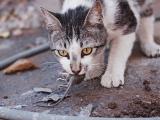Oct 14, 2010 (CIDRAP News) – In a move that sets the stage for the official eradication of the deadly cattle plague rinderpest, animal health authorities are ending all field activities to control the disease, theUnited Nations Food and Agriculture Organization (FAO) announced today.
The achievement marks the first time humans have eradicated an animal disease in the wild and the second time since smallpox in 1980 that humans have eliminated a disease, the FAO said in a press release.
Rinderpest, caused by rinderpest virus, doesn't infect humans, but it is considered a potential biological weapon threat because of the devastating effect it can have on cattle and buffalo herds, as well as some other wildlife species. An ancient disease, rinderpest is highly contagious and is accompanied by high morbidity and mortality rates.
The disease has never become established in the Americas, Australia, or New Zealand, but veterinary experts have been concerned about rinderpest introduction into those regions, because cattle herds there are naïve to the virus.
In affected countries, control measures have included vaccination, serologic monitoring, heightened awareness, and quarantine and slaughter of infected and exposed animals.
At a rinderpest eradication symposium in Rome today, FAO Director-General Jacques Diouf told the group that elimination of the disease has been one of the FAO's earliest priorities, according to the press release.
"The disease has affected Europe, Asia and Africa for centuries and has caused widespread famine and decimated millions of animals, both domestic and wild," he said. "In the 1880s, rinderpest caused losses of up to one million head of cattle in Russia and central Europe."
A separate 19th-century rinderpest outbreak in African livestock and wildlife killed millions of animals and sparked a famine that killed one third of Ethiopia's population, the FAO said.
In the 1980s rinderpest outbreaks hit South Asia, the Middle East, and Africa. During that time frame Nigeria reported $2 billion in livestock losses from the disease. A1994 outbreak in Pakistan killed more than 50,000 cattle and buffalo before the FAO and its partners brought the disease under control. The last known outbreak struck Ethiopia in 2001.
An international coalition of groups working on rinderpest eradication, the Global Rinderpest Eradication Program (GREP), recently issued a report outlining its successes and the steps that need to be accomplished before the eradication is declared next year.
The FAO and the World Organization for Animal Health (OIE) are expected to formally declare rinderpest eradicated in mid 2011 after they review final disease status reports from a handful of countries.
See also:
Oct 14 FAO press release
CIDRAP rinderpest overview
Oct 2010 GREP report

















